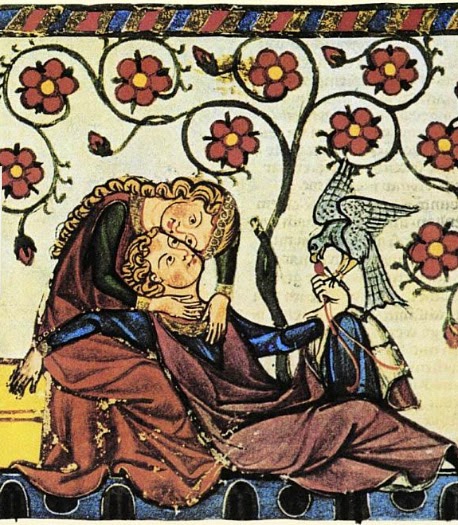Tristran
 Tristran, by Thomas of Britain
Tristran, by Thomas of BritainOne of the earlier versions of the Tristan and Isolde tale is one by "Thomas of Britain," who was probably writing for the court of Eleanor of Aquitaine. It's all rather fuzzy, but the clues seem to point that way, and certainly Thomas was writing for a courtly audience who expected certain things out of the story. This divides Thomas' story from the earlier Beroul, who is known as 'primitive' in contrast.
This tale of Tristran and Ysolt only survives in fragments. There are about 50 pages of material, and they start with the story already well underway. Tristran is living in the wilderness alone, after King Mark's suspicions got to be too much. In a truly strange addition, Tristran has life-like mechanical statues made of Ysolt and Brangvein (and their dog!). He keeps them in a cave, which he visits to lament his awful fate. Before long he marries Ysolt of the White Hands, and Thomas includes a long lament on the intolerable situations of all four, none of whom can have what they want.
 Tristran gains a companion, Lord Caerdin, who helps him contact Queen Ysolt. Caerdin becomes Brangvein's lover, but through a misunderstanding, Brangvein becomes angry with Ysolt and everyone else, and almost betrays them to King Mark--instead, she tells Mark that another knight is about to become Ysolt's lover. This is all cleared up, but only to move on to the last chapter, which leads to the deaths of both Tristran and Ysolt.
Tristran gains a companion, Lord Caerdin, who helps him contact Queen Ysolt. Caerdin becomes Brangvein's lover, but through a misunderstanding, Brangvein becomes angry with Ysolt and everyone else, and almost betrays them to King Mark--instead, she tells Mark that another knight is about to become Ysolt's lover. This is all cleared up, but only to move on to the last chapter, which leads to the deaths of both Tristran and Ysolt.We only have a small amount of Thomas' composition, but luckily others used it as source material and have provided us with the rest of the story. Gottfried von Strassburg's Tristan is based on this version, and although it is unfinished, there is a great deal more of it. I'm reading that now.
This courtly strand of the legend has several elements in it that I have not run into before, so it's proving to be a very interesting read.




That was definitely the strangest courtly love tale I've read so far. I reviewed it in February: http://exploringclassics.wordpress.com/2014/02/14/review-of-le-roman-de-tristan-the-romance-of-tristan-and-yseut/
ReplyDeleteI haven't read the von Strassburg version. I look forward to reading your review of that version. 'm interested in knowing what the similarities and difference are between the two versions and which version you prefer.